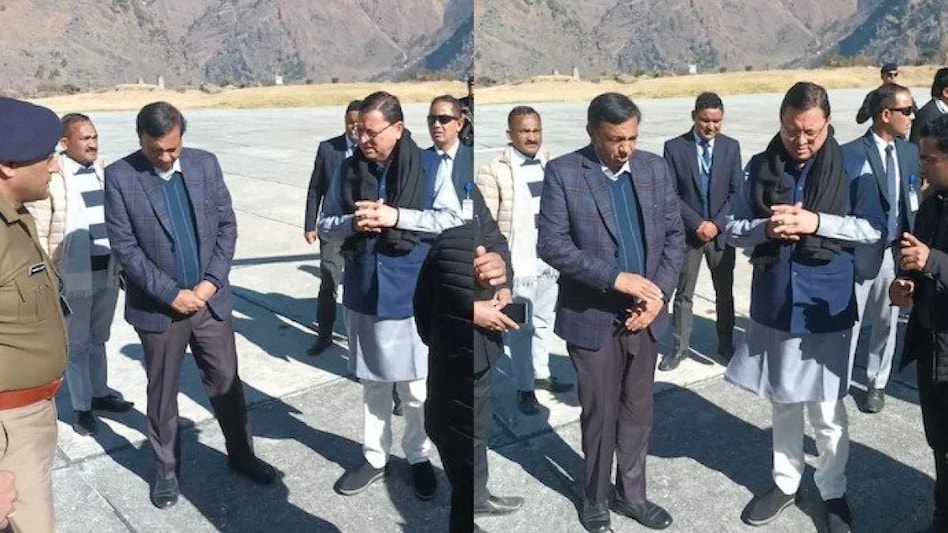Uttarakhand Chief Minister Pushkar Singh Dhami arrived in Joshimath on Saturday to inspect the areas affected by the landslide and meet with the affected families.
"Joshimath is an important and cultural place for us. Our main motive is to save everyone. Experts are trying to get the reasons behind it. We are trying to keep people at safe locations," CM Pushkar Singh Dhami told reporters after visiting the affected areas in the town.
The chief minister conducted an aerial survey of Joshimath. Additionally, he will visit the families who have been impacted and inspect the affected areas on the ground.
Land subsidence has caused at least 500 homes in Uttrakhand town, which is significant both religiously and culturally, to develop cracks and there is a chance that these might collapse. In Joshimath's Singdhar ward, a temple collapsed on Friday evening, further alarming the community's residents who already live in constant fear of a catastrophic event. Numerous experts have issued warnings that many of the town's homes are unlikely to survive.
Take a look at Joshimath: Key developments
- Joshimath, a spiritual town in Uttarakhand where Adi Shankaracharya, a religious reformer, attained enlightenment in the eighth century, has come to national attention for a very unsettling reason. Huge cracks have appeared in several local homes, and because the town is perched on a precarious mountain slope, residents are terrified that it will completely sink.
- On January 6, Chief Minister Pushkar Singh Dhami ordered the immediate evacuation of 600 families who were living in homes with significant cracks. "Saving lives is our first priority. Officials have been asked to shift around 600 families living in endangered houses in Joshimath to safe locations," Dhami said.
- While the situation was already bad, the collapse of a temple in Joshimath's Singdhar ward on Friday created more sense of fear for the locals who were already terrified. The temple had been abandoned after it developed significant cracks over the previous 15 days, so it was fortunate that nobody was inside when it collapsed.
- Although land subsidence has been a problem for more than a year, it has gotten worse recently, according to authorities.
- The worst affected area is in Marwari, where an aquifer burst three days ago. While water from the aquifer is continuously flowing down there with great force, several houses were damaged to varying degrees.
- All construction work on major projects like the NTPC's hydroelectric project and the Chardham all-weather road (Helang-Marwari bypass) has been halted until further notice.
- According to former local municipality president Rishi Prasad Sati, the Auli ropeway service was also suspended after a significant crack appeared beneath it. The largest crack in all of Asia appeared beneath the Auli ropeway.
- Chief Minister Dhami has stated that alternative locations in Pipalkoti, Gauchar, and other places should be identified for the permanent rehabilitation of affected people.
- A group of experts from the state government have been sent to the area to evaluate the situation. As a precaution, teams from NDRF have also been stationed there, according to Lalit Narayan Mishra, the Chamoli Chief Development Officer (CDO), who spoke on Friday (January 6). "We have to be alert for the future, so NDRF is being deployed as a precautionary measure," he said. "Due to frequent landslides, NDRF has been called and the team of experts is surveying the affected areas since this morning," he added.
- The town is in a state of panic. Many people have fled their homes out of fear. The administration is simultaneously moving people to gurudwaras, schools, and municipal buildings.
Also Read: Uttarakhand: Why is Joshimath ‘sinking’? Experts say warning bells started ringing from 1976
Also Read: Joshimath crisis: 600 families to be evacuated today; CM Dhami to visit temple town
 The chief minister conducted an aerial survey of Joshimath.
The chief minister conducted an aerial survey of Joshimath. The chief minister conducted an aerial survey of Joshimath.
The chief minister conducted an aerial survey of Joshimath.